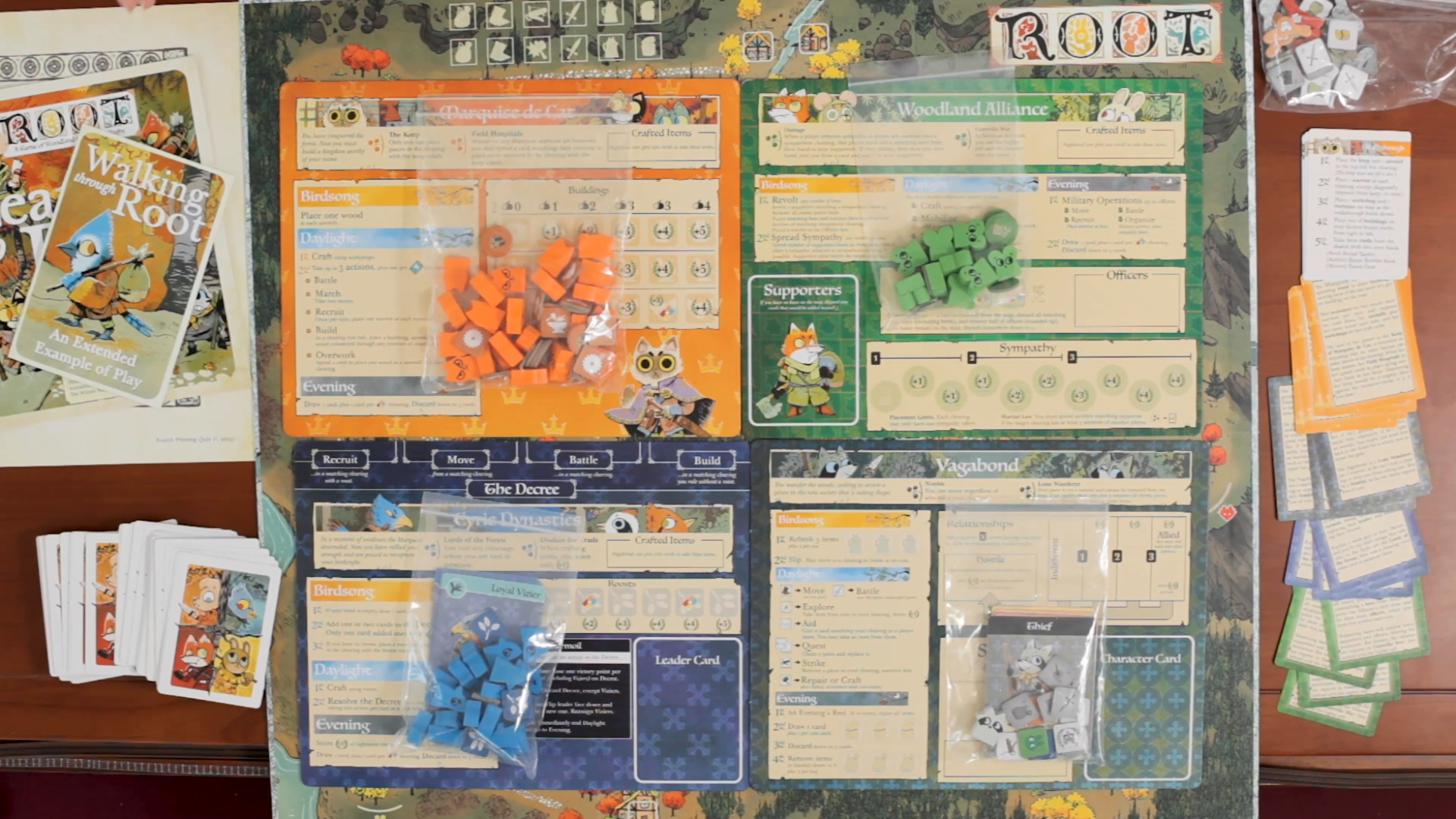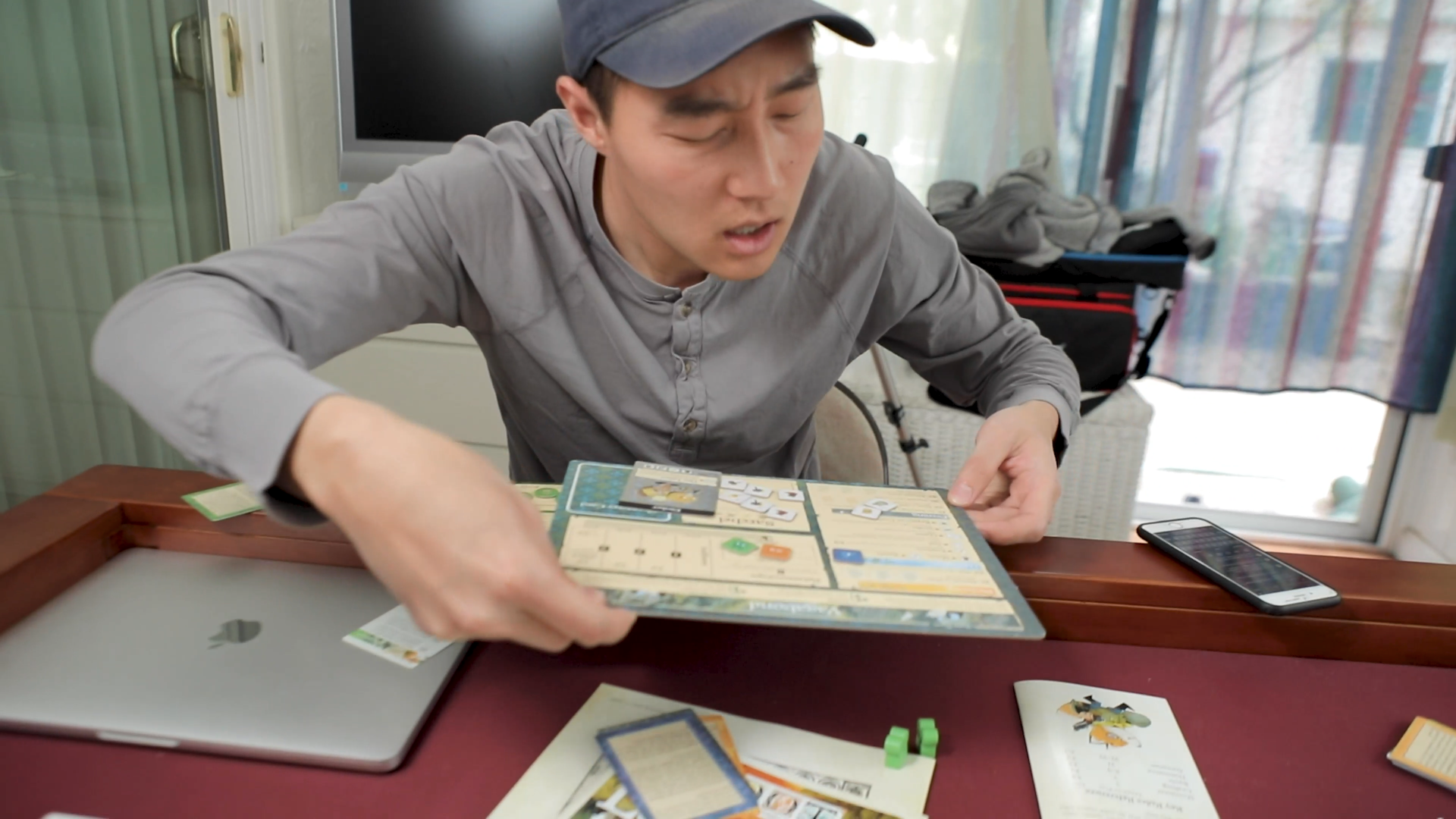Root Review
One of the deepest area control games out there, don’t get fooled by its cute aesthetic!
4 factions duke it out for control over their woodland home! Each faction is very asymmetrical, each with their own unique turn structures and victory point mechanisms! Plays in about 2 hours for 2-4 players, solo available through expansion.

Steep Asymmetry with 4 varied player boards!

Matching card colors to specific regions is one of the few ways to use cards.

Heavy player interaction to balance the forest!
Overview & How to Play
Sometimes different forest animals decide that they’re the ones that rule the wilderness, and they’ll utilize their specialties to seize it for themselves!
Every faction needs to score 30 points in order to win, but each of them do so in incredibly different ways. With the base game, there’s 4 included factions: The Marquise de Cat, The Eyrie Dynasty, the Woodland Alliance, and The Vagabond.
For the game’s fundamental rules, the only shared rulings are how movement, combat, and cardplay works. Other than that, all the factions have their own unique rules about how their actions work and how they try to score points.
As an example, the cats have a fairly straightforward turn structure. They first have an upkeep where they generate wood on some of their buildings. Then the bulk of their turn is performing up to 3 actions where they do basic area control actions like moving, attacking, and building using their Wood. Finally, when they end their turn they draw cards. They primarily score points by building more, well, buildings.
On the other end of this asymmetry, we got someone as crazy as The Vagabond. Instead of being an army of cats, you’re a lone raccoon running around like the board is an RPG world. The Vagabond’s actions are all based on item tokens they can gather either by exploring ruins around the map or by obtaining them from other players as a byproduct of them playing cards. Upkeep for the Vagabond involves them refreshing some of their items, and then their action phase is comprised of them exhausting certain items to do certain actions. Boots = moving, Sword = attacking, Torch = explore ruins, you get the idea. The Vagabond scores either by completing quests from their personal quest deck, or by getting involved with the other factions by either befriending or antagonizing them.
Pros
Truly, playing as a different faction is its own form of satisfaction, cause piloting different factions can almost feel like playing different games. Mastery of one faction is incredibly satisfying, but then on top of that, getting to see all the different factions clash and play around each other’s strengths and weaknesses is an incredibly rewarding experience as well.
Because the 3 basic fundamentals of fighting, moving, and cardplay are always going to integral to everything, once you have those down, then you can always meaningfully understand how to interact with everyone else. The interesting part then becomes knowing how everyone else bends the rules a bit to their advantage and playing around that.
The Woodland Alliance as an example always have advantage in combat whereas normally the attackers have advantage. As a tradeoff, they have substantially less units and actions to work with.
Meanwhile, the Eyrie Dynasty have to program their actions beforehand with an absurd amount of actions. Because of this, it’s possible for them to establish turns that are much stronger than anyone else’s. However, they HAVE to execute their entire action structure, meaning that by glancing over at their board, you can identify where you can attack them for maximum effect by either forcing them to do useless actions, or even better: causing them to crash if it becomes impossible to perform their action queue, effectively skipping their turn.
It’s with these incredibly unique gameplay circumstances that Root really impresses. Barely any other games will have its players thinking over the game state in such interesting and unique ways, and it makes you feel all the more clever when you identify those absurdly crazy play-lines.
Cons
Unfortunately, Root does suffer from accessibility issues because of its very nature. However, it definitely could’ve addressed this problem better with stronger player aids. It’s a lot to ask a completely new group to pick up Root, because whoever’s teaching it is ideally going to have to know how ALL the factions work if they’re going to be able to answer questions. While it is possible for them to just understand how moving, battling, and cardplay works and to just explain those while everyone familiarizes themselves with their own faction, that definitely isn’t a smooth start.
Thankfully, Root does have a learn to play guide and walkthrough that really does help the flow of information for newcomers. These do an excellent job of bringing players in before directing them to the “Law of Root”, which is an amazingly organized, comprehensive listing of every ruling in the game. Root also has amazing faction boards that self-explain themselves super well. Anyone who understands Root’s rules should be able to read their faction’s ability board and understand how everything works. Maybe not so much how to play them well, but learning them, that’s the fun part.
The problem is solely in better being able to concisely understand how opposing factions work. There are some brief description cards included that you can give out to each player, but they’re honestly not the greatest, and somewhat obscure the actual gameplay workings with thematic fluff.
And finally, there are some minor balance issues, namely, that in the base game there are a couple of outlier power cards and a slight favor towards the Woodland Alliance and Vagabond factions. However, this can be mitigated because of Root’s area control politics, but also, if you’re playing enough to get to that level of efficacy and winrate, you’re probably decently invested into Root. At that point, there’s so many expansions to pick up, where you can add new factions, new maps, npc’s, and full on bot players if you need to increase table presence. If you’re that deep in, balance and accessibility aren’t going to be issues, especially with varied rulesets and all sorts of extra mechanisms to throw in that’ll shake things up to unforeseen levels.

















